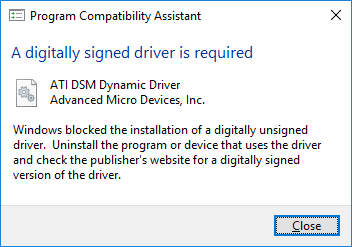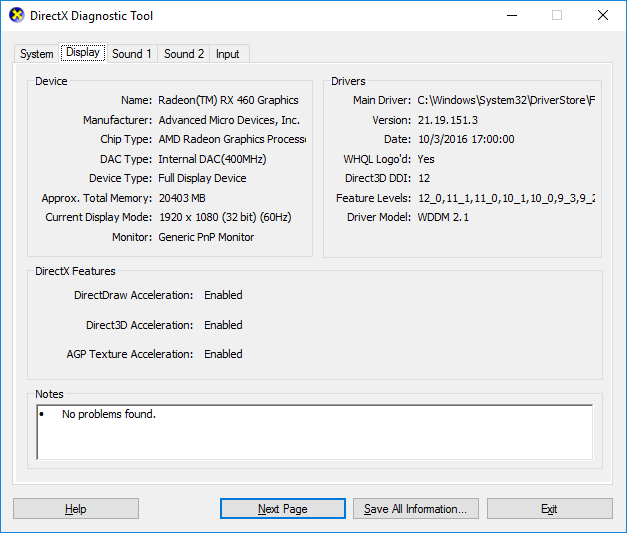Examining Windows 10 Anniversary Update's Driver Signing Enforcement Policy
by Brett Howse on October 14, 2016 1:00 PM EST- Posted in
- Software
- AMD
- Operating Systems
- Windows
- Microsoft
- NVIDIA
- Windows 10

Windows 10 Anniversary Update came out at the beginning of August, with plenty of new user-facing features. There were also plenty of changes under the hood as well, including a change in policy regarding how Windows 10 handles device drivers.
When the 64-bit versions of Windows launched over a decade ago, as a security measure Microsoft decided to require that all kernel mode drivers must be signed to be loaded. Under the aptly named cross-signing requirement, hardware vendors would need to get a certificate from one of the major certificate authorities, and use that to sign their drivers. The idea being that by enforcing signing restrictions, it would be much harder for malware to masquerade as legitimate drivers.
This however didn't go quite as well as planned. In particular, malware authors begun stealing driver signing certificates from hardware vendors, allowing them to distribute malware that was for all practical purposes authentic as far as the operating system was concerned. As a result, when Windows 10 initially launched, Microsoft decided to take things one step further and require that not only would kernel mode drivers need to be signed, but that they would need to be WHQL signed by Microsoft.
With that said however, Microsoft's plans hit a snag. There were technical complications to this decision, as well as a problem with the ecosystem being ready for this change. So for Windows 10, WHQL signing was a policy statement and not something that was enforced.
Now with the rollout of the Windows 10 Anniversary Update (version 1607) this policy is no longer just policy, but an enforced requirement: in a fully secure x64 system, all kernel mode drivers must be signed by Microsoft. But, as with all rules, there are exceptions. The new requirement does not affect anyone who has upgraded from a previous build of Windows 10, and therefore it only affects new clean installs of Windows 10 1607. Furthermore the policy is only enforced if Secure Boot is enabled, so for those that require the ability to run traditionally (non-Microsoft) signed kernel mode drivers, one possible work around is to disable Secure Boot. As a backwards compatibility measure, Microsoft is also allowing the installation of drivers signed with end-entity certificates issued before July 29, 2015 which are signed by a supported CA. Finally, to prevent boot issues, boot drivers will not be blocked at this time, but the will be blocked in future versions of Windows.

An example of a warning notice for a driver now blocked under Windows 10 Anniversary Update
Getting to heart of matters then, the additional signing requirements for Windows 10 piqued our curiosity on driver compatibility, and as a result we've gone and taken a quick look at how this change impacts the average user. In practice, it shouldn’t impact very many people at all, as many hardware vendors only ship WHQL (Microsoft signed) drivers to begin with. But there is one particular segment of hardware manufacturers that still semi-regularly release non-WHQL drivers, and that's the GPU vendors. Both AMD and to a lesser extent NVIDIA periodically release beta, hotfix, and other types of drivers that aren't WHQL signed. The obvious question then is raised: will users still be able to run these non-WHQL driver releases under Windows 10 Anniversary Update?
To answer that question, we reached out to both companies for comment, and while only NVIDIA got back to us, they are not too concerned:
"All of our Game-Ready driver releases are fully WHQL certified, so this shouldn’t significantly impact GeForce users at all." - NVIDIA Spokesperson
As NVIDIA only releases the occasional non-WHQL hotfix driver, they are less likely to be impacted to begin with. And indeed, they haven't had a hotfix release since before the release of Windows 10 Anniversary Update. AMD on the other hand has had a couple such releases, so we decided to simply see what would happen if you installed a non-WHQL driver release on a Secure Boot enabled system.
As it turns out, even AMD driver releases marked as non-WHQL are still sent to Microsoft for signing. And as a result they install on Windows 10 Anniversary Update just fine. Now to be technically accurate, AMD could always ship an unsigned driver if they deem it necessary. But as we can see, some thought has been put into this, and the company isn't releasing any drivers that won't install under Windows 10 Anniversary Update. Nor, do I expect that NVIDIA would ship unsigned hotfix drivers either.
The net impact to the average user then is essentially zero. Having drivers that are signed by Microsoft but not fully WHQL does blur the line between what is and isn't really WHQL. But because all drivers are being signed regardless of WHQL status, it means that non-WHQL drivers are just as usable under Windows 10 Anniversary Update as they were before with the original release of Windows 10. This, ultimately, was the conclusion we expected to find. But it's nice to be able to confirm what we've already suspected.
Source: Microsoft Hardware Certification Blog











85 Comments
View All Comments
DomOfSF - Friday, October 14, 2016 - link
im...im sorry. "Enforcesment"?Lolimaster - Friday, October 14, 2016 - link
My solution is simple, keep win7 and play win10 only games on youtube. I only care about story mode.sl149q - Friday, October 14, 2016 - link
There are three essential changes. First all drivers must now be signed by Microsoft. Second you can have any driver signed for you by Microsoft. there is no charge, typical turnaround time is 15 minutes. Third you must authenticate yourself to Microsoft by having an EV Code signing certificate.This is all about preventing people with stolen code-signing certificates signing drivers (think Stuxnet.) EV Certificates are distributed on a security key, so harder to steal. If your dongle goes missing you probably will realize it is stolen and the cert can be cancelled.
frodesky - Friday, October 14, 2016 - link
Curious, but how did you modify the print servers so the drivers would install?Lapog - Friday, October 14, 2016 - link
JoeyJoJo123 - Friday, October 14, 2016 - link======================================================
That's a mute point. Bare in mind that it's a doggy-dog world out there, and $250 fees for software licensing can make or brake a company. In lame man's terms, Microsoft is a business, and businesses gotta make money. It's in any businesses' best interests to charge for whatever they can, and Microsoft will probably start that up again. By not charging, they're acknowledging that they're playing a zero-sum gain.
But you know, just take with these words with a grain assault.
=====================================================
I logged in just to acknowledge your post - a masterful combination of whimsical and wise. Thank you. You made my day.
johnyp - Saturday, October 15, 2016 - link
It seems that not all AMD drivers carry a digital signature their last release for the 5850 card does not have a digital signature. Hence the new update installed and lo behold big crash !!!! So who is responsible my card is fantastic, even some of the latest cards cant match it. So who is to blame for the fact that I my system went bang so to speak..AMD ?? I don't think so !! All worked 100% before the update..Klimax - Saturday, October 15, 2016 - link
Seems like certificate is problematic, but it should have on. As for some cards still not matching, evidence required...Achaios - Sunday, October 16, 2016 - link
"My 2009 card is so good, and y'all n00bs for buying $800 GPU's".Alexvrb - Saturday, October 15, 2016 - link
BS meter pegged! If you read the article you would have noticed this doesn't affect updated systems, only fresh installs with AE preinstalled (at this point, only new OEM boxes really). So no, your crash is unrelated. Second, and possibly also unrelated, that 5850 is an antique compared to new cards. Sorry. It's Terascale architecture. Even a lowly RX 460 would beat it.Alexvrb - Saturday, October 15, 2016 - link
Also if you did have a new install with this signing enabled, you could disable Secure Boot to turn it off. No, your crash is unrelated to this feature. I'd bet you picked up some malware at some point that damaged your system files or something along those lines.